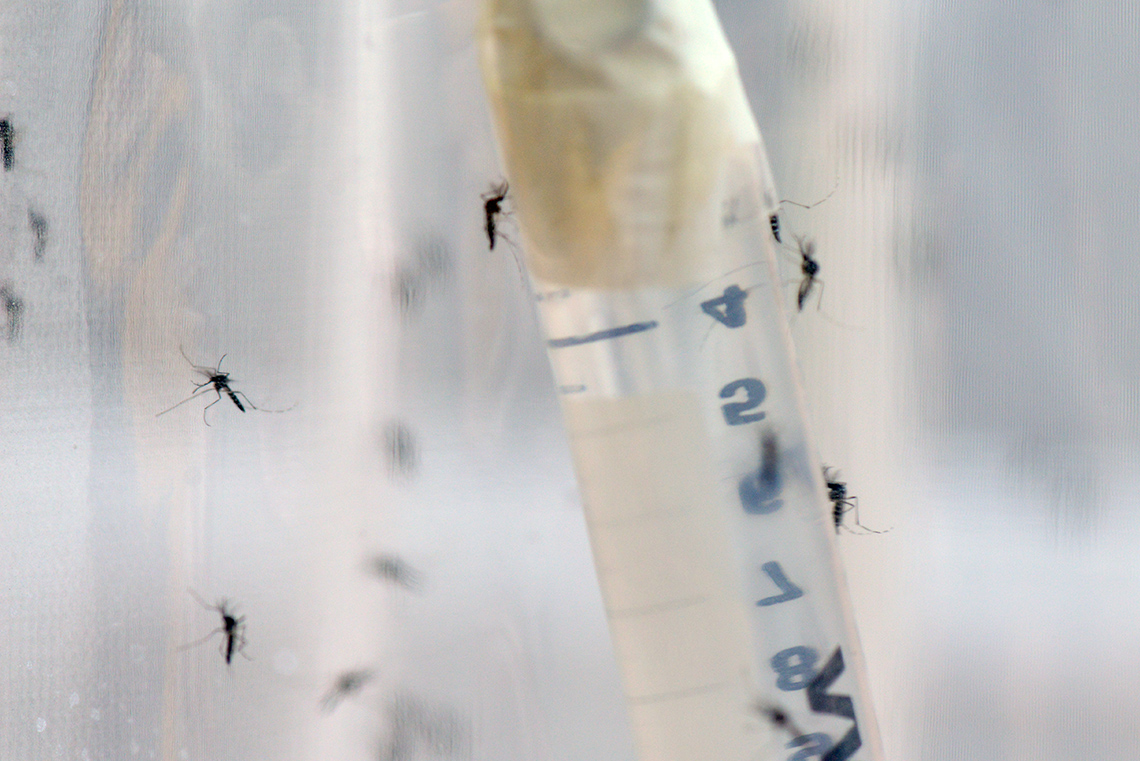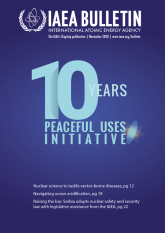
If you would like to learn more about the IAEA’s work, sign up for our weekly updates containing our most important news, multimedia and more.
Nuclear Science to Tackle Vector-Borne Diseases
Sinead Harvey

Mosquitoes at the Insect Pest Control Laboratory. (Photo: D. Calma/IAEA)
Nuclear science to tackle vector-borne diseases
Mosquitoes are among humankind’s deadliest enemies because of their ability to transmit diseases such as malaria and Zika virus disease, which can cause devastation on a global scale. However, some countries are using a nuclear-based birth control method, the sterile insect technique (SIT), to combat mosquito-borne illnesses such as dengue. One such country is Bangladesh.
“Dengue ravished Bangladesh on an unprecedented scale in 2019. There were over 100 000 reported cases, our health system was overwhelmed with people suffering from severe flu-like symptoms, and more than 150 people lost their lives,” said Mahfuza Khan, Director of the Institute of Food and Radiation Biology at the Bangladesh Atomic Energy Commission. Prolonged monsoon rains provided the ideal breeding ground for the Aedes species of mosquito, which spread dengue and other diseases such as Zika and chikungunya. “As we are fighting to save people from these diseases, our efforts to control mosquitoes should be focused on an integrated approach, including the use of the SIT.”
“ The Aedes mosquito is invasive to our area and is increasingly resistant to insecticides, making traditional control techniques less effective.
Bangladesh turned to the IAEA for assistance in August 2019. A four-year plan was then developed for implementing the SIT as part of an area-wide integrated pest management programme to control Aedes mosquitoes.
Several countries, including Brazil, Cuba, Germany, Greece, Indonesia, Italy, Malaysia, Mauritius, Mexico, Spain and the United States of America are developing the use of SIT for mosquito control. Bangladesh is also developing its use with support from the Peaceful Uses Initiative (PUI).
The SIT is an environment-friendly technique whereby target insects are mass-reared and then sterilized using radiation.The sterile males are packaged up and sent to the infested areas and released to mate with wild females. The mating results in no offspring, reducing the wild insect population over time. This technique has been used for over 70 years and has been successful in controlling several agricultural insect pests.
“Following the request from Bangladesh, the IAEA, in cooperation with the Food and Agriculture Organization of the United Nations (FAO), sent a multidisciplinary team to assess the outbreak and help local experts develop a plan for the use of the SIT, in combination with other methods, to suppress the mosquitoes spreading the disease,” said Rui Cardoso Pereira, Head of the Insect Pest Control Section in the Joint FAO/IAEA Division of Nuclear Techniques in Food and Agriculture.
Since 2016 the initiative has received almost €2.5 million in funding from Japan, the United Kingdom and the United States to help advance SIT-related research and development for mosquito control and overcome the challenges of using it on a wide scale for Aedes mosquitoes, as well as Anopheles mosquitoes, which spread the malaria parasite.
Mass rearing mosquitoes
“With mosquitoes, there are certain challenges that have to be overcome before the SIT can be used on a large scale,” said Cardoso Pereira. The first of these challenges is how to feed and rear the mosquitoes that are to be irradiated for release.
Research and development efforts have improved the cost-effectiveness of mass rearing. The switch from stainless steel to cheaper aluminium and plastic in the design of racks and cages, among other improvements, allows for larger-scale implementation of mass rearing conditions.
Separating females from males
It is female mosquitoes that bite and pass on disease, so ensuring that only the sterilized males are released is crucial.
In Aedes mosquitoes, males and females can be separated at the pupal stage, as female pupae are significantly larger than male pupae. This method, however, is not always precise, as pupal size is affected by conditions such as diet, rearing conditions, density of the insect population and other environmental factors. Therefore, to further optimize the separation of male and female Aedes mosquitoes, scientists in the Joint FAO/IAEA Division have, as part of a PUI-supported project, developed a genetic sexing strain that brings out red eye colour in females and black eye colour in males, which is expected to facilitate sex separation in SIT applications.
Irradiating mosquitoes
Historically, gamma ray irradiators have been used for the mass sterilization of insect pests as part of SIT programmes. Recent research conducted by the IAEA and FAO has shown that X-ray irradiators are also suitable for this process. It is with X-rays that scientists at the Lee County Mosquito Control District (LCMCD) in Florida, United States, are carrying out their SIT programme on the Aedes mosquito in collaboration with the IAEA. “The Aedes mosquito is invasive to our area and is increasingly resistant to insecticides, making traditional control techniques less effective,” said Rachel Morreale, Applied Science and Technologies Manager at LCMCD. “As our programme is sterilizing via X-rays and not gamma rays, we can provide a different perspective and approach.”
The LCMCD received support from the IAEA, including assistance with the calibration of its X-ray machine. “The experiences that we have learned and the improvements that we have made can be of great assistance to other countries,” added Morreale.
Drones for release of fragile pests
Mosquitoes are fragile, and it is important that their release into the environment during an SIT programme does not damage or kill them. Researchers in Brazil and experts from the Joint FAO/IAEA Division have found that drones could offer a solution. A study conducted by these researchers in 2018 showed that using drones for release causes minimal damage to the insects, as well as being more cost-effective and faster than other release techniques, such as release from the ground.
“For the Brazilian team, the use of drones was an innovative approach to reduce the costs of large-scale releases,” said Maylen Gómez Pacheco, technical-scientific manager at Biofábrica Moscamed Brasil. “We can share the results of this trial, through the IAEA, to support SIT pilot trials in other epidemiological and social contexts to control mosquitoes and minimize the suffering of many communities around the world.”
This article was featured in the November 2020 edition of the IAEA Bulletin marking 10 years of the Peaceful Uses Initiative. On 23 February 2021, the Joint FAO/IAEA Division of Nuclear Techniques in Food and Agriculture was renamed the Joint FAO/IAEA Centre of Nuclear Techniques in Food and Agriculture.







